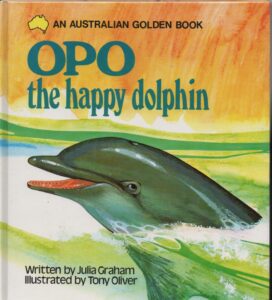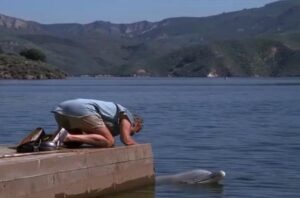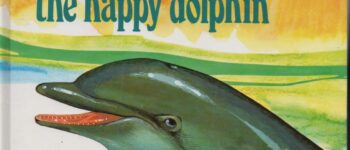1955: Opo
March 7, 2022
By AHNZ

Today in history, 9 March, 1956, the dolphin idolised by New Zealand was found dead in a tidal rock pool. During that Atomic Age summer of 1955/56 she was a big deal to New Zealand as well as to the wider world. By rigorous consistency, this Opononui visitor had the same naming system applied to it that earlier friendly dolphin and ship escort Pelorus Jack (1888-1912.) The Hokianga dolphin was initially named Opononui Jack but upon discovery that she was a she, the name simply became Opo.
Opo was important to the whole world because she broke down a wall between wild animals and people. Not since antiquity has a dolphin been recorded as behaving like a trusting domestic pet. Opo brought joy and connection to people, swam with them, gave them rides then dumped them off her back when she pleased to pick up someone else. She balanced balls and bottles and performed tricks to the delighted Kiwis. Hitherto, dolphins were considered dangerous fish with deadly teeth hardly worth distinguishing from a shark. When Opo and Jack’s older cousins were seen in Nelson waters they were fired upon with a machine gun.
Maoris kept themselves and their children distant from Opo. They were still a superstitious peasant people in the 1950s as this was prior to their Second Great Migration. The dolphin, to them, was considered a monster sent by pagan gods. According to one account a secret ritual and prophecy had been performed 12 months prior predicting the return of demigod Kupe to the Hokianga in the shape of a fish.¹ If so it’s curious Maoris didn’t approach.
 Opo showed the entire world what was possible. One of the people watching was John C. Lilly, a conventional American scientist who became a specialist in altered consciousness and inter-species communication. The world moved in a different direction to Lilly, leaving his dolphin communications attempts and sensory deprivation tanks and LSD experiments on the fringe or in science fiction land. For example, Lilly banging away in his old age still trying to talk to dolphins must have been the inspiration for Captain Nathan Bridger who was doing the same as a recluse before being lured back to service in the iconic TV show SeaQuest DSV (1993.)
Opo showed the entire world what was possible. One of the people watching was John C. Lilly, a conventional American scientist who became a specialist in altered consciousness and inter-species communication. The world moved in a different direction to Lilly, leaving his dolphin communications attempts and sensory deprivation tanks and LSD experiments on the fringe or in science fiction land. For example, Lilly banging away in his old age still trying to talk to dolphins must have been the inspiration for Captain Nathan Bridger who was doing the same as a recluse before being lured back to service in the iconic TV show SeaQuest DSV (1993.)
Somehow, in 1955, enough New Zealanders in the Hokianga reacted in a different way and an attachment was formed between dolphin and man instead of violence. Those first few people who met a sharp-toothed wild animal made a choice to open up instead of to fight or flight as if Jaws were coming to eat them for breakfast. After the man-dolphin rapport was established thousands more people caught a vibe that spread world-wide.
As always, not everyone could make the transition to the new dolphins-are-benign mindset. Recriminations go around that Opo was helped into the tidal rock pool that stranded her and killed her by jealous fishermen and they dynamite. Their concern about dolphins had become warranted by the usual suspect that generally provides a dark and damaging influence throughout New Zealand history: Our Government. On March 8th, 1956, the Fisheries (Dolphin Protection) Regulation made it unlawful for any person to take or molest any dolphin in the harbor. Such a precedent was a blow to fishermen whose livelihoods and status were now legally threatened in a very practical way. However, practical matters were of no concern to Sydney Holland’s National 1.0 Government. What mattered was a bit of virtue signalling: Being the government on the side of the beloved national icon or whatever.
I think the joy and horror of Opo’s Summer robbed the first young Baby Boomers of their innocence. The last of the Silent Generation had already been set to that tone thanks to Parker-Hulme murder and the Mazengarb Moral Panic. Boomer role models had offered pictures, stories, books, songs, laws, and even a movie about Opo. Next thing you know part of the story is that your dolphin is dead and strung up from a tree by the tail as if at the freezing works. These WW2 era adults, you can be sure, would not have helped the young grieve with empathy. They were, after all, the same people who were sending their Boomer babies off to battery farm birthing units with the full approval and financing from The State. Compared to the systematic thrashings the previous generation had ensured the Boomers should be saying “thank you” not sobbing over their broken dolphin.
Skippyflipper
The rapport with Opo captured the Western imagination and led to all sorts of anthropomorphic human companions in the form of animals. Flipper (1963) is the obvious one but the way was open for all sorts: horses, bears, chimps, kangaroos, lions, bears. It seems that when Opo’s Baby Boomer friends grew up they offered Generation X kids shows based around this Skippyflipper trope and the audience showed a large appetite for more.
“And, it’s the Atomic Age. Our Rutherford split the atom after all and now we can blow up Pacific atolls and power entire cities. We won WW2, we sold lots of wool, we’re going to buy ice cream for our 5 children…Uranium flavoured ice cream..” – 1955: Uranium flavoured ice cream, AHNZ
“What it was: Anthropomorphic horses, bears, orangutans, chimps, dophins, kangaroos, elephants, dogs; Lassie, Ben, Mr Ed, Flipper, Skippy, Littlest Hobo etc. Behind the artistic, these animals were human characters who could think and act. Sometimes they had supernatural powers, often they exceeded or at least rivaled human intellect, emotional intelligence, and ability. ” – 1970s: Anthropomorphic Television Demigods, AHNZ
“Too often the fate of wild animals that befriend humans is untimely death.” – New Zealand: History & Natural History, Facebook (2014)
“Very few local Maori played with Opo. They believed Opo was a taniwha, a messenger sent by Kupe back to to his point of departure for Hawaiki….But Opo’s visitation didn’t bring together Maori and Pakeha cultures. It didn’t even bring Pakeha together. Instead the coming of Opo released contradictory forces that are perhaps in all New Zealand communities but which are rarely seen so openly: loyalty and envy; gentleness and viciousness; trust and scepticism; generosity and avarice.” – New Zealand Folk Song
“…1955! Unbelievable,…It could mean that that point in time inherently contains some sort of cosmic significance… almost as if it were the temporal junction point for the entire space-time continuum!” – Doc Brown, Back to the Future II (1989)
In creating fiction about friendly animals the Boomers could console themselves about their lost Opo. An imaginary animal friend never dies. If an animal cast member does die then the production team can just roll out another look-alike Lassie or fire up some animatronics.
The death of Opo marks a boundary between two New Zealand history Turnings. We moved from a First Turning Golden Weather High to the Second Turning Nambassa Awakening. During the High our nation had put crisis behind and forged a new civic order, a stable consensus. During the Awakening our social and spiritual ideals came into question and the young searched for meaning which they found in crime, cults, drugs, protest, music, ‘peace’, Feminism, surfing, environmentalism etc. It’s tempting to think all of this 1956-1978 Awakening and consequent Unraveling and today’s Crisis could have been averted if that dolphin had have pulled through! However, that would be like trying to freeze time by holding back the hands on a clock.
—
1 Ref. p1755, New Zealand’s Heritage (1971)
Ref. also 1970s: Anthropomorphic Television Demigods, AHNZ
Ref. Dr Turbot examining dead Opo, Opononi; Museum of New Zealand, Digital NZ
Image ref. This book seemed ubiquitous in primary school libraries of the 1980s. Probably because the Ministry of Education had some kind of bulk deal. Graham’s title was a GenX update of the old ‘Gay Dolphin’ moniker which now had different connotations; Cover of Opo the Happy Dolphin, Julia Graham (1979)
 Like Comment Share
Like Comment Share





